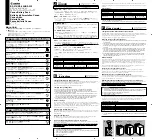
4.5.
SEALED BATTERIES
4.5.1.
Charge a sealed battery very slowly, carefully monitoring the voltage across the battery terminals using a normal tester.
4.5.2.
When the battery terminal voltage reaches 14.4V for 12V batteries or 28.8V for 24V batteries, stop charging.
4.6.
MULTIPLE CHARGING
WARNING!
DO NOT
simultaneously charge different types of battery or batteries with different capacities or levels of discharge.
4.6.1. Simultaneous multiple charging should be carried out in series, since this enables monitoring of the current circulating in each battery.
See fig.5 below.
NOTE: If two batteries with rated voltages of 12V are connected in series, set the battery voltage selection key on the front panel to
24V and move the positive cable to the 24V terminal.
4.6.2.
When fully charged, the ammeter reading should be close to “0” and the electrolyte in the battery should begin to gas. Stop charging to
protect the battery plates from damage.
DO NOT
continue to charge a fully charged battery, as this will damage the battery.
DO NOT
leave a battery on charge unattended.
4.7.
END OF CHARGING
4.7.1.
Switch the charger off and unplug from mains power. Disconnect the power clamps, clean the charger and store in a safe, dry area.
4.7.2.
Replace the battery electrolyte cover or caps. Wipe up any splashes or spillage (remember that the electrolyte is a corrosive acid).
4.7.3.
Return the battery to the vehicle, secure according the manufacturer’s instructions and re-connect. Check to ensure that all tools are
removed before closing the bonnet or boot.
4.8.
RAPID CHARGING
4.8.1.
The START560 and the START660 both have a rapid charge function which is controlled by the fast-charge timer device to a
maximum of 60 minutes.
4.8.2.
To initiate rapid charging turn the fast-charge timer device to the required charging time in minutes and turn the charging level rotary
switch to one of the fast-charge charging levels of either 4,5 or 6. When the preset time has elapsed the current is automatically
switched off. Turn the charging level rotary switch to the ‘off’ position.
4.9.
STARTING
WARNING!
DO NOT
attempt to start engine with starter/charger if the battery is disconnected from the vehicle. The presence of the
battery is essential for the elimination of possible over voltage that may be generated due to energy accumulating in the connection
cables at the starting stage.
4.9.1.
Check the vehicle manufacturer’s handbook and follow any special instructions. Check that the battery is in good condition.
4.9.2.
Insure the starter/charger is disconnected from the mains power supply and, for models with dual voltage output, set the output voltage
to the same as the vehicle battery i.e. 12 or 24 volts.
4.9.3.
Check that the charger clamps and battery terminals are clean and free from oxidation.
4.9.4.
Without removing the cables that connect the battery to the vehicle, first connect the charger POSITIVE (red) lead to the POSITIVE (+)
terminal on the battery. Then connect the NEGATIVE (-) (black) lead to the chassis, remote from the battery and the fuel line.
Starting will be greatly eased if the battery is given a short charge before the ignition switch is turned. This must always be done with
the selector switch set to the charge position and NOT to boost. Plug starter/charger into mains power supply, select a low rate of
charge and turn on. Allow the battery to charge for 2-3 minutes.
4.9.5.
Move the starter/charger switch to the ‘START’ position (see figs.2 & 3). Turn the vehicle ignition on and crank the engine for a
MAXIMUM of 3 seconds. If the vehicle does not start, wait 120 seconds and then try again to a maximum of 5 cycles.
WARNING!
If the vehicle will not start,
DO NOT
continue as vehicle battery and electrical circuits may be damaged, and the fuse in the
charger will blow. Disconnect the charger and investigate for vehicle faults.
4.9.6.
When the vehicle is running successfully, switch the starter/charger off, unplug from the mains power and disconnect the power
terminals from the battery.
4.10.
FUSE
4.10.1. The starter/charger is equipped with a safety fuse, or fuses, which will cut the power to the unit in the following circumstances:
a) Overload - too high a current to the battery.
b) Short circuit - clamps touch, or cross-connection to battery.
c) Prolonged starting attempts.
4.10.2. Should the fuse blow take the following action:
Turn the unit off and disconnect from the mains power supply.
Allow the unit to cool down, establish the reason for failure and correct.
Replace the fuse (under fuse cover on control panel).
DO NOT
use a fuse with copper bridge or similar as these will damage
your starter charger. Refer to Section 2 ‘Specifications’ for fuse information. We recommend that you hold 2 spare fuses with
the starter/charger.
NOTE:
The use of an incorrect fuse will invalidate your warranty.
Fig.4
Fig.5
Original Language Version
© Jack Sealey Limited
START320, 420, 560.V2, 660 Issue:3 (1) 26/06/20























